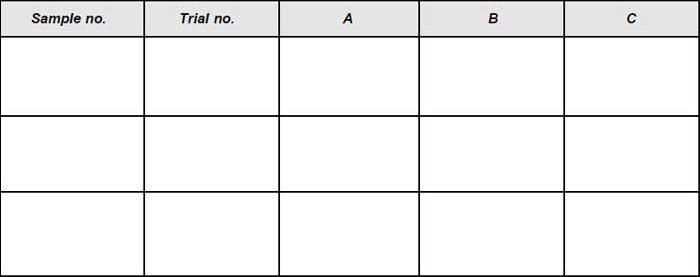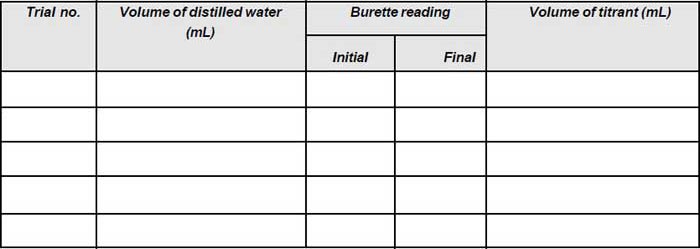Test for Residual Chlorine
B. STARCH IODIDE METHOD
A. OTA METHOD
Aim
To determine the amount of free residual chlorine, combined residual chlorine and total residual chlorine present in the given samples of chlorinated water.
Principle
Orthotolidine (OT) is an aromatic compound that is oxidised in acid solution by chlorine, chloramines and other oxidising agents to produce a yellow coloured compound, holoquinone at pH less than 1.8, the intensity of colour being proportional to the amount present. Orthotolidine-arsenite (OTA) method is based upon the fact that free residuals chlorine react instantaneously and chloramines slowly (5 minutes) with orthotolidine. Total residual chlorine is measured with readings after 5 minutes have elapsed. A second test is made in which a reducing agent (sodium arsenite) is added within 5 seconds after ‘OT’ is added. This allows time for free chlorine to react before the arsenite is added. The arsenite being a much stronger reducing agent than ‘OT’, reduces the chloramines instantaneously stopping further action with OT. The yellow colour developed in this case is primarily due to the residual chlorine. Then,
- Total residual chlorine - Free residual chlorine = Combined residual chlorine
- Chloroscope
- Cuvettes
- Comparator discs.
Reagents (click to check the preparation of reagents)
- Orthotolidine reagent
- Arsenite reagent.
Procedure
- Pour the sample into the middle chamber of the cell of the chloroscope. Add 0.5 mL of 'OT' and mix well with the plunger. Fill the outer chambers with chlorine free distilled water. Wait for 5 minutes. Put the yellow coloured discs in position and compare the colour. Note the reading (A).
- As in step 1 first add 'OT', mix quickly and immediately add arsenite reagent. Note the reading (B).
Note: If the colour is not in the range of the given discs, the experiment may be done by diluting the sample with distilled water and then multiplying the result by the dilution factor.

Total residual chlorine = A mg/L = .........
Free residual chlorine = B mg/L = .........
Combined residual chlorine = (A – B) mg/L = .........
Results

Aim
To determine the amount of total residual chlorine present in the given samples of chlorinated water by starch iodide method.
Principle
Chlorination of water supply is done to destroy or deactivate disease-producing micro-organisms. It will also improve the quality of water by reacting with ammonia, iron, manganese, sulphide and some organic substances. The residual chlorine is maintained in water to promote the primary purpose of chlorination. This method of determination depends upon the oxidising power of free and combined chlorine residuals. Chlorine will liberate free iodine from potassium iodide solution at pH 8 or less. The liberated iodine is titrated against standard sodium thiosulphate solution using starch indicator.
- Burettes
- Pipettes
- Erlenmeyer flask.
Reagents (click to check the preparation of reagents)
- Concentrated glacial acetic acid
- Potassium iodide
- Starch indicator
- Iodine solution 0.025N
- Standard sodium thiosulphate solution (0.025 N).
Procedure
- Take 25 mL of sample in an Erlenmeyer flask.
- Add 5 mL acetic acid to bring pH in the range 3-4.
- Add 1g of potassium iodide and mix thoroughly.
- Titrate with 0.025 N sodium thiosulphate solution until a pale yellow colour is obtained.
- Add 1mL of starch solution and titrate until the blue colour disappears. Note down the volume of sodium thiosulphate solution added (V1).
- Take a volume of distilled water corresponding to the sample used. Add 5 mL acetic acid, 1 g potassium iodide and 1mL starch solution.
- If blue colour occurs, titrate with 0.025 N sodium thiosulphate solution until the blue colour disappears.
Record the volume of sodium thiosulphate solution added (A1). - If no blue colour occurs, titrate with 0.025 N iodine solution until the blue colour appears (A2).
- Then titrate with 0.025 N sodium thiosulphate solution till the blue colour disappears. Record the volume of sodium thiosulphate solution added (A3). Note down the difference between the volume of iodine solution and sodium thiosulphate as A4.
Note: Blank titration is necessary to take care of the oxidising or reducing reagents' impurities.
Observation
Chlorinated sample x Standard sodium thiosulphate solution (0.025 N)

Distilled water × Standard sodium thiosulphate solution (0.025 N)

Distilled water x Standard iodine solution (0.025N)

| Residual chlorine in mg/L = | (V – A1) or (V + A4) x N x 35.46 x 1000 | =.......... |
| mL of sample |
Results





